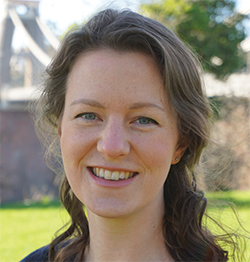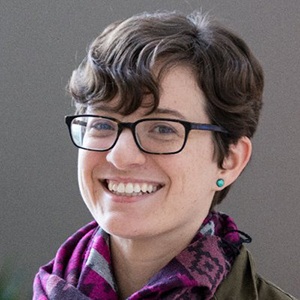Tabor award for bacterial colony work
Why can a bacterium usually found in the mouth also drive an infection linked to heart failure? How does a nascent bacterial colony in the heart protect itself from being swept away? Catherine Back won a 2018 Journal of Biological Chemistry/Herbert Tabor Young Investigator Award for her work on the mechanism of adhesion between a bacterial fibril protein and human tissues.
 Catherine Back found a novel mechanism for streptococcal adhesion to fibronectin. Courtesy of Catherine Back
Catherine Back found a novel mechanism for streptococcal adhesion to fibronectin. Courtesy of Catherine Back
The protein, which she characterized while she was a postdoctoral fellow at the University of Bristol, helps the oral bacterial species Streptococcus gordonii attach to and colonize human tissues and may contribute to bacterial infection of the heart.
Back’s first research experience was as an undergraduate at Bristol, where she worked with microbiologist Howard Jenkinson on an interaction between S. gordonii and another species of commensal oral bacteria. She stayed on at Bristol for her Ph.D., extending her undergraduate studies with a closer and more multidisciplinary look at CshA, an adhesion protein.
“I thought it was really interesting to work on a protein that not much was known about,” she said.
While Jenkinson remained her primary supervisor, for her project, Back drew on the expertise of three principal investigators from two departments. Jenkinson and Angela Nobbs were frequent collaborators on microbiology research in the dental school, while biochemist Paul Race contributed expertise in protein characterization.
“I managed to work in both departments, learning microbiology and also structural biology,” Back explained. The collaboration between the groups continues to this day. The labs now work together to characterize other bacterial adhesins.
After earning her Ph.D., Back stayed on in Bristol to finish the work described in her JBC article and then moved to the nearby University of Bath to study a new type of vaccine for tuberculosis.
Back grew up in Exeter in Devon, England, and said she enjoys getting outdoors both in Bristol and on visits home. “I often go back to my parents’ house in Exeter,” she said. “It’s near the sea, and near Dartmoor, which is a really nice place to go hiking.”
Back recently returned to Bristol to join the lab of Paul Race for a new project, studying antimicrobials from bacteria that colonize deep-sea sponges.
Catching fibronectin to clamp on tightly
Adhesion proteins are key drivers of bacterial colony formation. In the case of S. gordonii, the protein CshA contributes to binding to the human extracellular glycoprotein fibronectin.
Because S. gordonii can enter the bloodstream and adhere to heart valves, the binding mechanism may have implications for development of heart infections.
Catherine Back and colleagues at the University of Bristol divided a relatively uncharacterized region of the protein into three domains through bioinformatic analyses, publishing their work in JBC in December 2016.
They analyzed each domain’s interaction with fibronectin, finding that one of the three domains did not interact. Of the remaining two, dubbed NR1 and NR2, the on and off rates for NR1 were faster, although NR2 was capable of higher affinity binding. They analyzed the structure of both domains, determining that both are responsible for fibronectin binding. The disordered NR1 domain interacts transiently with fibronectin, the so-called catch. After NR1 makes initial contact, NR2 binds more tightly — the clamp.
Back suspects the binding she described may be relevant to other pathogens. A number of other streptococci “have CshA-like proteins, which have a similar sequence and may have a similar mechanism of interaction,” she said.
Enjoy reading ASBMB Today?
Become a member to receive the print edition four times a year and the digital edition monthly.
Learn moreGet the latest from ASBMB Today
Enter your email address, and we’ll send you a weekly email with recent articles, interviews and more.
Latest in People
People highlights or most popular articles

Mydy named Purdue assistant professor
Her lab will focus on protein structure and function, enzyme mechanisms and plant natural product biosynthesis, working to characterize and engineer plant natural products for therapeutic and agricultural applications.

In memoriam: Michael J. Chamberlin
He discovered RNA polymerase and was an ASBMB member for nearly 60 years.

Building the blueprint to block HIV
Wesley Sundquist will present his work on the HIV capsid and revolutionary drug, Lenacapavir, at the ASBMB Annual Meeting, March 7–10, in Maryland.

In memoriam: Alan G. Goodridge
He made pioneering discoveries on lipid metabolism and was an ASBMB member since 1971.

Alrubaye wins research and teaching awards
He was honored at the NACTA 2025 conference for the Educator Award and at the U of A State and National Awards reception for the Faculty Gold Medal.

Designing life’s building blocks with AI
Tanja Kortemme, a professor at the University of California, San Francisco, will discuss her research using computational biology to engineer proteins at the 2026 ASBMB Annual Meeting.

